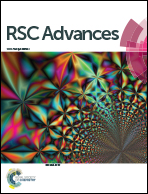Insight into mechanism and selectivity of propane dehydrogenation over the Pd-doped Cu(111) surface†
Abstract
The catalytic activity and selectivity of the Pd-doped Cu(111) surface toward the dehydrogenation of propane have been explored by density functional theory calculations with periodic boundary conditions. Four models with different Pd ensembles are introduced to represent the Pd/Cu(111) surface, where a surface single-atom catalyst model is built by alloying Cu with Pd. Calculations reveal that the d band center of the surface Pd atom is upshifted with the increased number of Pd atoms, resulting in an enhanced adsorbate–surface bonding strength and a reduced dehydrogenation barrier. The embedded Pd atoms can significantly improve the catalytic reactivity of the pure Cu surface, whereas the presence of the relatively inactive Cu surface is beneficial for the high selectivity toward propylene dehydrogenation. In general, the Pd/Cu(111) surface with the atomically dispersed palladium catalytic centers demonstrates good balance between the activity, selectivity, thermal stability and the maximum use of the noble metal, and shows great potential in the catalytic production of light olefins.


 Please wait while we load your content...
Please wait while we load your content...